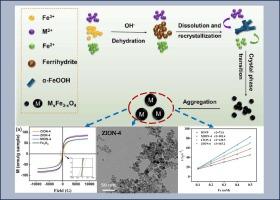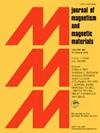具有增强磁性能的离子掺杂铁基纳米粒子:通过共沉淀法合成和形成机制
IF 2.5
3区 材料科学
Q3 MATERIALS SCIENCE, MULTIDISCIPLINARY
引用次数: 0
摘要
铁基磁性纳米粒子在生物医学领域备受关注。然而,通过共沉淀法制备的铁基纳米粒子的磁性能往往不能满足应用要求。本研究旨在通过共沉淀法合成铁基磁性纳米粒子,并以不同比例掺杂 Mn2+、Zn2+ 和 Co2+ 离子,从而提高铁基磁性纳米粒子的性能。其中,掺杂比例为 0.6 的 Zn 纳米粒子(ZION-6)的饱和磁化强度最高,为 98 emu/g,r2 值最高,为 165.2 mM-1-s-1,是一种有效的 T2 MRI 造影剂。我们对共沉淀过程的研究揭示了离子掺杂磁性铁基纳米粒子的形成机制。该机制包括形成中间相 α-FeOOH,然后进行相变、离子掺杂和小颗粒聚集,最终形成磁性纳米颗粒。这项研究可为开发性能更佳的磁性纳米粒子铺平生物医学应用的道路。本文章由计算机程序翻译,如有差异,请以英文原文为准。

Ion-Doped Iron-Based nanoparticles with enhanced magnetic properties: Synthesis and formation mechanism via coprecipitation
Iron-based magnetic nanoparticles have gained significant attention in biomedicine. However, the magnetic properties of iron-based nanoparticles prepared through coprecipitation methods often do not meet application requirements. This study aims to enhance the performance of iron-based magnetic nanoparticles by synthesizing them via the coprecipitation method and doping them with Mn2+, Zn2+, and Co2+ ions in various ratios. Among these, Zn-doped nanoparticles with a 0.6 ratio (ZION-6) exhibits the highest saturation magnetization intensity of 98 emu/g sample and the highest r2 values of 165.2 mM−1·s−1, making them an effective T2 MRI contrast agent. Our investigation into the coprecipitation process revealed a formation mechanism for ion-doped magnetic iron-based nanoparticles. This mechanism involves the formation of an intermediate phase, α-FeOOH, followed by phase transformation, ion doping, and the aggregation of small particles to yield the final magnetic nanoparticles. This research could pave the way for developing magnetic nanoparticles with improved properties for biomedical applications.
求助全文
通过发布文献求助,成功后即可免费获取论文全文。
去求助
来源期刊

Journal of Magnetism and Magnetic Materials
物理-材料科学:综合
CiteScore
5.30
自引率
11.10%
发文量
1149
审稿时长
59 days
期刊介绍:
The Journal of Magnetism and Magnetic Materials provides an important forum for the disclosure and discussion of original contributions covering the whole spectrum of topics, from basic magnetism to the technology and applications of magnetic materials. The journal encourages greater interaction between the basic and applied sub-disciplines of magnetism with comprehensive review articles, in addition to full-length contributions. In addition, other categories of contributions are welcome, including Critical Focused issues, Current Perspectives and Outreach to the General Public.
Main Categories:
Full-length articles:
Technically original research documents that report results of value to the communities that comprise the journal audience. The link between chemical, structural and microstructural properties on the one hand and magnetic properties on the other hand are encouraged.
In addition to general topics covering all areas of magnetism and magnetic materials, the full-length articles also include three sub-sections, focusing on Nanomagnetism, Spintronics and Applications.
The sub-section on Nanomagnetism contains articles on magnetic nanoparticles, nanowires, thin films, 2D materials and other nanoscale magnetic materials and their applications.
The sub-section on Spintronics contains articles on magnetoresistance, magnetoimpedance, magneto-optical phenomena, Micro-Electro-Mechanical Systems (MEMS), and other topics related to spin current control and magneto-transport phenomena. The sub-section on Applications display papers that focus on applications of magnetic materials. The applications need to show a connection to magnetism.
Review articles:
Review articles organize, clarify, and summarize existing major works in the areas covered by the Journal and provide comprehensive citations to the full spectrum of relevant literature.
 求助内容:
求助内容: 应助结果提醒方式:
应助结果提醒方式:


